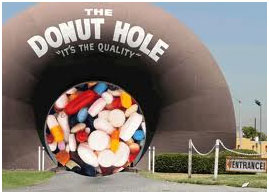Prescription plans are one of the newest Medicare concepts having been bought into existence in 2003, but were effective from January 2006. Medicare Part D Plans have been drafted to cut down the sedatives expenses, not covered in original Medicare plans.
Before prescription plans were executed, people of Medicare eligible age often found difficulty paying bills for prescription drugs.
These insurance coverage are administered by private insurance companies and premiums vary on the basis of gender, county, plan and deductibles, which are considered to be very high in part D plans.
On getting an insurance plan, a card tagged along with other documents is mailed to the grantee. This card is used for further purchase of drugs and the costs of co-payment, co-insurance and deductibles is to be borne by the user.
Part D Plans are generally structure based, as opposed to being based on the needs or the requirements of the bearer.
Enrolling in prescription Plan:
One simple reason to enroll in coverage is that the premiums to be paid under this plan are quite ‘RESONABLE’. With varied options available in the market, having a backup plan for drugs at a cheaper rate is always considered to be a good option, especially when they have a fatal coverage stage limiting your annual expenditure!
If someone wishes to enroll in a Part D Plan, they should try avoiding following two factors, which might prove negative for the beneficiary:
- Avoid Being Late: Once you are late in enrolling after being eligible, there is a penalty of 1% of the premium that has been calculated. This penalty is charged on a monthly basis.
- Try Calculating the Correct Enrollment Time Slot: The second setback with the Part D of Medicare Plan is that one can take on the policy only during the fixed time of the year. If one misses the initial enrollment they would need to wait till the next slot is scheduled.
One needs to be very careful about the time slots and if not may land up paying huge bills on prescription drugs.
Coverage Gaps in the Medicare Part D Plan:

One of major drawbacks of the Part D of Medicare Plan is the “DONUT HOLE“
This is the terminology used for the coverage gap between the starting coverage limit and the catastrophic coverage limit.
Across the board, every grantee is required to pay approximately $310 in deductibles and one fourth of the coverage limit that is approximately $2,800. When one exhaust the limit, the beneficiary is required to pay 100 % of the drug costs. After surpassing the donut hole, the insured person would be paying five percent of the cost of the drug for the year.
Drugs Boycotted by Medicare Plan:
There are several drugs that are banned or do not come under the coverage of prescription Plans. Some of these have been listed below:
- » Anything that doesn’t come under scrutiny of the Food and Drug Administration (FDA)
- » Any drug which is illegal to be sold in the U.S
- » Any prescription made beyond the specified parameters
- » Any drug to be used for cosmetic purposes
- » Any drug that is used to shed extra pounds of weight
- » Any generic drug to treat colds
- » Any prescribed vitamins
- » Any drug that would need a test done, prescribed by its designee or the manufacturer
Albeit, they are excluded from the general list of the drugs included in Medicare coverage, they can be included as a supplemental add-on to the existing drug plan.
Acceptance and Criticism of prescription coverage:
Part D of Medicare Plan come with certain leverages and critiques. They can be categorized as below:

It is always advisable to consider these factors before one can jump to a conclusion of whether to buy a Medicare plan or not.
To conclude, Part D of Medicare Plan can be summarized as a supplement to provide millions of senior citizens with access to the drugs which were difficult for them to previously afford, helping them to maintain a healthy life over subsequent years. Adding a drug plan to the Original Medicare policy always provides peace of mind for those emergency costs that might pop up in future.

